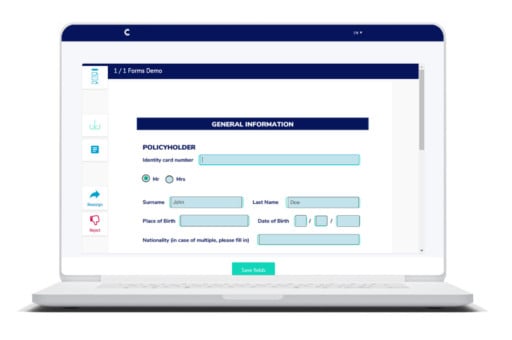As we’re approaching the end of 2020, it’s time to think ahead and identify a few things we can likely expect in the coming year(s). 2020 has been a year where electronic signing and identification have known quite an uprise, due to the fact that a big part of the world had to adapt to remote working and confinement. What are five trends to expect or anticipate next year? Let’s dive in.
1. Extra features for added value
As we already know, a digital signature has multiple levels of reliability and can be divided in three types, as defined by eIDAS:
- Basic or Simple Electronic Signature (SES)
- Advanced Electronic Signature (AES)
- Qualified Electronic Signature (QES)
With levels of reliability we mean that each of these signatures have a degree of verifying the signers identity, to a certain extent. A Basic Electronic Signature is usually more used in lower-value processes because there is no ‘foolproof way’ to confirm the identity of the signer.
A Qualified Electronic Signature, on the other hand, binds the signer’s identity to its signature by means of a personal, qualified certificate, issued by a Qualified Trust Service Provider (QTSP), ensuring the identity of the signer to the highest degree possible.
To get into the details of each of these types of signatures, you can read one of our previous blog posts.
Something we expect to grow in 2021 is the extra added value on each of these different types of signatures. Meaning that on top of a certain level of security & reliability you get with a digital signature, there are extra features available that extend the useability of a digital signature portal or API, allowing you to get more required information out of your signers.
As an example, a few of the things we offer to our users at Connective to provide extra added value to our digital signature solution is the Forms Feature and the Audit Trail.
Automated contract creation & form filling
The Forms Feature allows our users to set up forms in their signing process to gather more information of the signing parties and use this data for contract automation. For instance, an investment company that needs documents signed to onboard a new client can insert a form in the signature process where the new client has to tick off his monthly or yearly budget and the languages they speak and understand for clear communication purposes. The values are automatically included to the signed document, allowing faster and more efficient document automation.
Even though this feature has been around for a while, we expect it will become even more important in the years to come, as this ensures an even faster & smoother signing flow.

Audit Trail
The Audit Trail feature attaches an on-demand overview of each signed document in the portal, that contains information related to the delivery and signing process. This allows users to track and audit the digital signatures transparently, so that each transaction can be traced.
It’s basically the same story as the previous feature: even though this is already in the picture for a while, its availability will get a lot more significant when digital signatures become more & more implemented in companies & industries worldwide. Since it tracks the document status from start to finish, including all the stops & steps, it will become a very important feature to have in your provider’s solution.

More information on audit trails can be found here.
To conclude, we expect that many digital signature providers will continue expanding the features of their respective solutions to make sure the users have access to a wide range of extra, useful features outside of the use of a digital signature itself.
2. Artificial Intelligence
A trend we could also expect in the coming year(s) is the rise of Artificial Intelligence (AI) in the world of digital signing. Everyone has heard of it, and AI has made its shiny entry in many sectors & industries worldwide already. So what can it potentially mean for providers and users of digital signature solutions?
AI could make its entry in our world by means of automated systems that, based on certain entry data, know which documents need to be generated so it can automatically choose the correct template from a template library and prepare the signing process automatically. This means it configures the template, chooses the right (legally valid) signature method for that type of document and prepares all the steps so all you have to do is enter the signers and possibly the order of signing.
Another possibility is AI being used to automate and facilitate certain processes that are already in use now. For instance, in many T&C’s or contracts of numerous retailer websites that offer purchasing from a distance/online, you can find the term ‘cooling-off period’. This refers to the consumer’s right to an amount of time where you are allowed to change your mind about something you’ve purchased from a distance, whether it be a product or a service. In some specific cases, it is very possible that you are only allowed to sign a contract or document after an obligated cooling-off period.
AI could very well be integrated here as well to, based on the document that’s being entered, analyze & predict the workflow that needs to be set up and prepare it for signing with the correct settings & measures in place.
3. Adaptations to laws concerning digital signing
This is something we can’t predict and we absolutely don’t want to advise on, but it is likely that we’ll see some changes or adaptations of laws concerning digital signing in the near future. Since the concept of digital signing will continue to expand and evolve, the rules around it will have to as well.
Fednot (Royal Federation of Belgian Notaries) have been pushing their quest for digitization through in the beginning of 2020 with a solution for a completely digital execution of deeds by notaries. This changed the existing law and provides the possibility for powers of attorney to be granted both electronically and remotely, under certain conditions. A huge step forward in this sector. Not only in Belgium do we see this trend arise, other European countries are on the verge of this breakthrough as well.
For a more detailed explanation on this topic, consult one of our previous blog posts by our Legal Counsel, Nathan Schryvers.
Another example is eIDAS (regulation for electronic identification and trust services). The European commission has been evaluating this regulatory framework by means of an open consultation a few months ago. They have collected feedback and are assessing if it remains fit for purpose in its current state or that it needs to revised, so we can expect more news on that pretty soon.
Again, we can’t foresee the future but given the examples above, we expect some additional changes later on.
4. Use of verified identities to sign documents
An electronic signature by use of a verified identity is something that has been a gamechanger in quite some countries. Itsme® digital ID for example is an initiative by Belgian Mobile ID, a joint venture of 7 companies (the biggest Belgian banks and telco companies), that provides you with a digital ID based on your eID or verified bank data.
This allows you to easily log in to governmental institutions or digitally sign documents with a qualified electronic signature, the highest identity ensuring signature of them all. And the best of it all, there is no more need for external devices like a card reader, the only thing you need is your mobile device.
This initiative is on the rise in a lot of other countries as well. France for example has their FranceConnect initiative, that we recently added to our digital signature solution as a signing method. The level of security depends on certain factors, but nevertheless this method allows you to use your digital identity for signing the majority of available documents. Next to that, more and more countries will be issuing eID’s in the near future, so expect these types of services to pop up around the world.
5. The rise of mobile device usage
It’s hard to think of a world without mobile devices nowadays. Frankly there is little you can’t do with your mobile phone. Mobile banking, online shopping, … you name it. And of course, using your mobile device for digitally signing documents is a must.
We already have SMS OTP (One Time Password) configured as a signing method in eSignatures, allowing you to simply verify your identity by entering a one-time code sent to you by SMS (serves as a Simple Electronic Signature and can be set up as Advanced, when meeting certain specific requirements).
And as a qualified option of course, there’s ‘itsme® sign’ that can be used as signing method. This fifth trend can be considered as the logical step after number four. With more and more digital ID’s being created, the use of mobile devices for digitally signing documents with that digital ID will grow too, thus making our beloved mobile device even more important and present in the near future.
The world is literally at the tip of your fingers.
Conclusion: a wide range of possibilities
These are just a few of the things we think is very likely to be introduced or further developed in the coming years. Since the whole concept of digital signing has rapidly evolved due to current circumstances, who knows what might be introduced or thought of? The possibilities are not endless, but nevertheless very broad. We are as curious as all of you to see where this will take us and what will be possible in the near future, with our solutions and the rest of them.
Questions? Don't hesitate to contact us!



